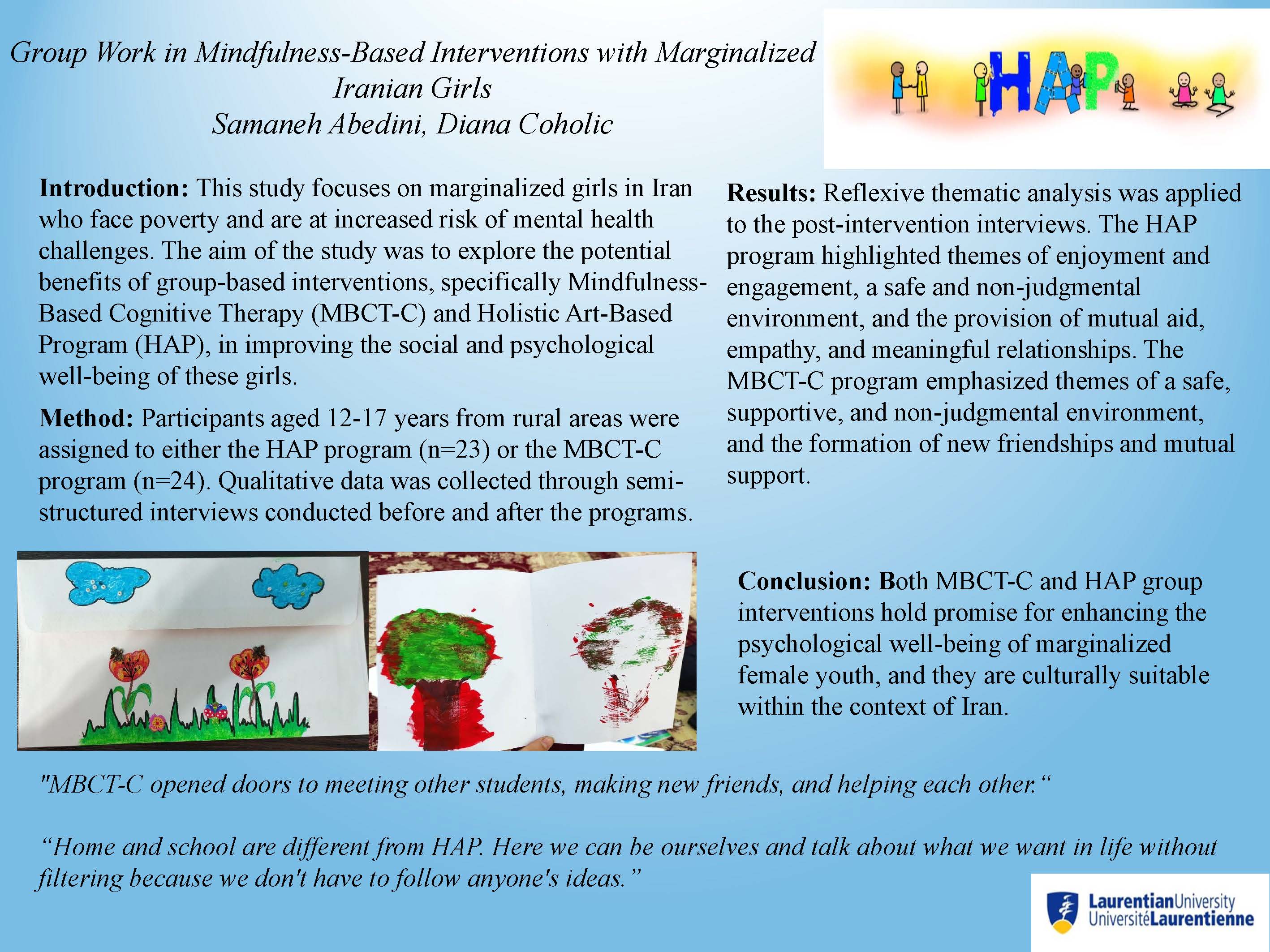Group Work in Mindfulness-Based Interventions with Marginalized Youth
Samaneh Abedini Najafabadi, Laurentian University, Sudbury, ON (Canada)
This presentation will explore the benefits of two Mindfulness-Based Interventions (MBIs), MBCT-C and HAP, for marginalized Middle Eastern youth. Both programs were delivered in a group. MBCT-C emphasizes personal development through shared experiences, while HAP focuses on anti-oppressive and feminist approaches. Through examples of activities and quotes from youth participants, attendees will learn how these MBIs improve emotion regulation and resilience, and have the opportunity to engage in a mindfulness activity themselves.
View Poster PDF
Presentation Description:
The purpose of this presentation is to demonstrate how marginalized youth from the Middle Eastern culture participating in two different Mindfulness-Based Interventions (MBIs), MBCT-C (Mindfulness-Based Cognitive Therapy for Children) and HAP (Holistic Art-based Program), benefited from group work similarly and differently. Both programs are designed to be delivered in a group format, but they conceptualize group work differently in terms of theory, practice innovations, and evidence. MBCT-C is taught using social construction, humanistic, existential, and spiritual perspectives/theories.1 The MBCT-C developers focused on group dialogue and encouraging participants to express their unique perspectives and suggestions for integrating mindful awareness into their daily lives. The developers believed that through this shared dialogue, the group dynamic evolved, establishing the group as a safe and secure environment. MBCT-C emphasizes personal development through shared experiences of the application of MBCT-C in participants' daily lives as a source of individual and group empowerment. In MBCT-C groups, facilitators are expected to be active participants rather than instructors to create a space less formal than schools.2 MBCT-C’s innovative activities can help participants to gain a higher self-awareness. MBCT-C has been shown to be effective at improving the mental health of youth mostly through quantitative research that measures psychological outcomes.3HAP has been guided by holistic, strength-focused, anti-racist, anti-oppressive, and feminist approaches.4 Facilitators provide a non-judgmental space for participants where everyone has a voice to speak and will be heard through collaborative and creative group work that respects individual identities. HAP includes social group work practices that facilitate learning mindfulness principles like self-compassion and cultivate a safe place for youth to feel respected and understood. The innovative art-based activities in HAP promote normalization, validation, a sense of belonging and inclusion, uniqueness, and diversity, which leads to a sense of acceptance, empathy, and understanding that despite the fact that each member has unique characteristics, their diversity can be a strength for the group (together we are stronger). HAP is shown to improve resilience, utilizing adaptive coping strategies, and emotion regulation in vulnerable youth.5Participants in my presentation will be taught about some examples of MBCT-C and HAP activities that helped marginalized youth in my Ph.D. project enhance their self-awareness and self-acceptance. Participants will learn how HAP facilitators create a "safe space" in the group. They will learn about some techniques in MBCT-C that assist children in regulating their emotions and choosing a more adaptive response to stressful situations. During this presentation, participants will be engaged by reading some quotes from marginalized youth who have participated in the HAP or MBCT-C programs detailing what they have learned from MBIs or how they have benefited from these programs. It may be possible for participants to complete an activity from either HAP or MBCT-C and, if they wish, they may also share their experiences with that activity. Several art works done by HAP participants will be shown to engage the participants visually and facilitate understanding of how mindfulness can be taught through an art-based activity.
References:
- Melaas, L. (2015). Affluent Youth And Wellbeing: Integrating Three Psychotherapeutic Approaches In Group Therapy. Saint Mary's College of California. https://www.proquest.com/pagepdf/1779976055?accountid=12005
- Semple, R. J., & Lee, J. (2014). Mindfulness-based cognitive therapy for children. In Mindfulness-based treatment approaches (pp. 161-188). Academic Press. https://doi.org/10.1016/B978-0-12-416031-6.00008-6
- Wright, K.M., Roberts, R. & Proeve, M.J. Mindfulness-Based Cognitive Therapy for Children (MBCT-C) for Prevention of Internalizing Difficulties: a Small Randomized Controlled Trial with Australian Primary School Children. Mindfulness 10, 2277–2293 (2019). https://doi.org/10.1007/s12671-019-01193-9
- Coholic, D. (2020). Promoting Resilience in Youth Through Participation in an Arts-Based Mindfulness Group Program. In: McKay, L., Barton, G., Garvis, S., Sappa, V. (eds) Arts-Based Research, Resilience and Well-being Across the Lifespan. Palgrave Macmillan, Cham. https://doi.org/10.1007/978-3-030-26053-8_5
- Coholic, D., Schinke, R., Oghene, O., Dano, K., Jago, M., McAlister, H., & Grynspan, P. (2020). Arts-based interventions for youth with mental health challenges. Journal of Social Work, 20(3), 269–286. https://doi.org/10.1177/1468017319828864

